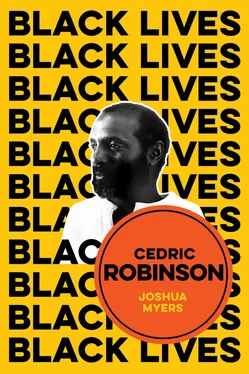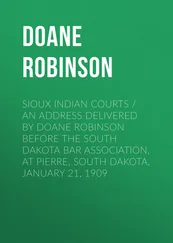There are a number of scholars, activists, and organizers whom I spoke to about this project. Many of them read drafts, offered encouragements, and gave me directions that are reflected in the final project. These include Ava Wilson, Shauna Morgan, Ashon Crawley, Bedour Alagraa, Imani Perry, Alan Minor, Mario Beatty, Valethia Watkins, Greg Carr, Donna Murch, Chris Roberts, Stefan Bradley, Jesse Benjamin, Minkah Makalani, Baba Lumumba, Anyabwile Love, and Ashanté Reese. Shauna and Ashon read early drafts of the first words of this text and kept me encouraged. Bedour sent me periodic texts that betrayed an authentic and welcome excitement that I was writing this book. I began one of the chapters while sitting next to Ashanté, on a day where I felt stuck and did not feel like writing. By the end of that session, the rest of the book came rather easily. Finally, Greg Carr introduced me to Cedric J. Robinson in 2006. Though it would take several more years for me to actually read this work closely, it was his engagement with that work and its relationship to Africana Studies that started all of this so many years ago.
I have been privileged to bring Cedric’s ideas into public spaces on several occasions. Conversations in new media helped propel my thinking a great deal before and while I was developing this text. I am grateful to Jared Ball, Jared Ware, and Joshua Briond for providing space to think in public with Cedric’s work. Special thanks to Sankofa Video and Books’ Haile Gerima and Addisalem Gebrekidan and the rest of the team who put together the “Critical Reading: How to Read Cedric Robinson” series. Sitting with Acklyn Lynch and his tattered copy of Black Marxism months later was a revelation. Finally, thanks to Darrell Johnson, Chad Kehinde Graham, Aliah Hill, Ayanna Jackson, and Danita Florence Warmack who took my seminar on Cedric J. Robinson at Howard University. You, and all my other students, gave me the opportunity to really know and appreciate his work.
Thanks to Polity Press’s George Owers and Julia Davies, who patiently shepherded this project through a very difficult time in human history. Thanks for believing in this project and for developing the Black Lives series.
A few final words for my friends: B. Nicole Triplett, who was with me when this work was at proposal stage and always provided space on my New York research trips. And to Chigozie Onyema whom I did not talk with a great deal about this project but who, when it comes to radicalism, was one of my first real interlocutors. Alexsandra Mitchell is always there, and when I first took this project on she said she cried. I feel her.
Introduction: Cedric’s Time
The Bakongo peoples of West-Central Africa saw Life as a cycle. This was not merely the invocation of the idea that all time is the same, that all experience is constant. Rather, what is meant is that we experience time in ways that allow us to see how all other time was experienced, that our experiences of time are not without deep connections to the cosmological. Human life is mapped, spatially oriented in the Kongo cosmogram ( tendwa nza Kongo ) as a mode of realizing how “the four moments of the sun” mirror not only individual lives, but also communal existence. We live our lives as we experience being within the larger universe. Human existence is akin to bodies arranged about the sun: constant motion and movement, darkness and light. But the creation of society, of human relationships within and amid existence, is not mechanical. The cycles that the Bakongo observed did not produce natural laws that govern our interaction in space. To be human, for the Bakongo, is to seek to understand, grow, and mature in rhythm with ancestors and the natural world, and to align them with a vision of and for community. Yet there is no guarantee that simply being alive will produce such connections. The Bakongo believed that tuzingu, or “rolls of life,” give us a record of what happened in the experiences of our ancestors, as we ourselves experience the cycles that mark our journeys around the sun. These records are required to pass down “lived accumulated experienceknowledge” to create social togetherness. They are there for us to see how it looked for others, so we can sense how it will be for us. Our lives are inherently linked, but they are our lives. 1As Jacob Carruthers writes, time and eternity coexist and are in communion. 2
Perhaps this is also a conceptual foundation for one definition of the Black Radical tradition found in the work of Cedric James Robinson. In the 2000 preface to his bestknown text, Black Marxism , he describes that tradition as “an accretion, over generations, of collective intelligence gathered from struggle.” 3Enslavement, inasmuch as it provided the occasion for struggle over and within a particular kind of existence, was ultimately a challenge that required Africans to remain connected, to create the records – the collective intelligence – of those struggles and prior knowledges in order to continuously apply them to the realization of an otherwise to that existence and a more familiar mode of being à la Bakongo. Cedric’s conception of the Black Radical tradition as that accretion, then, is consistent with the worldviews of our enslaved African ancestors. And we might easily find direct familial and ancestral ties between Cedric, an African with roots in Alabama, and the peoples of the region who conceived of the tendwa nza Kongo , who later found themselves in the western hemisphere in large numbers, helping to produce the artistic and spiritual cultures that have been collected under the designation, “black Atlantic.” 4
But, while interesting, an immediate genealogical relation is not required to reveal the greater insight: that these ways of seeing and imagining connections to each other across time and space were shared across Africana cultures. And so much so that what became the “deep thought” of the Bakongo might also be perceived as part of the tuzingu of countless other African intellectual traditions. 5That it appeared among Africans in a space called “the Americas” at a particular point in time is, however, also deeply significant and consequential in its own right. For it was in this context, this moment of the sun, that the foundation for that accretion of intelligence – of which the genius of significant Black thinkers was derivative, of which the thought of Cedric Robinson was derivative – was necessarily realized. 6This is to say, Cedric’s time occasioned a unique vantage point for comprehending reality and questions of existence that were both exceptional and constitutive of the very traditions he named and narrated.
The construct of time is useful – as any among a range of possibilities, such as space, geography, race, class, sociality, or systems – for thinking the life of Cedric Robinson. If the method of his work is, as Erica R. Edwards describes it, “to carefully excavate the mechanisms of power and to just as meticulously, and with a singular determination that I think can only be called faith , detail the radical epistemologies and ontologies that those mechanisms have been erected to restrain,” then we might use constructions of time as a route to understanding the ordering logic of those forces of restraint. 7This is indeed the aim of Damien M. Sojoyner, who writes in Futures of Black Radicalism that time, as a mechanism of restraint, structures and utilizes difference while imposing ideological adherence to the regimes that require that structuration by instituting the “disciplinary mechanisms aimed at ideological positions that counter western notions of law and order.” Resistance, then, if it is to be truly effective, requires us to initiate a “Black Radical time” – a time against the practices of difference making and othering. 8And within such alternatives to time as imposition, we would also develop alternative modes of relating to each other and to the past. Cedric himself perhaps sums up the importance of this framing most effectively in Black Marxism , where at a pivotal point in the text he states:
Читать дальше












